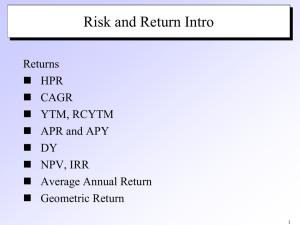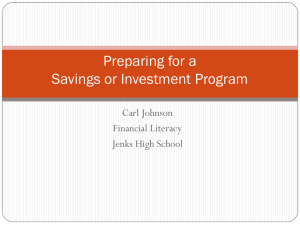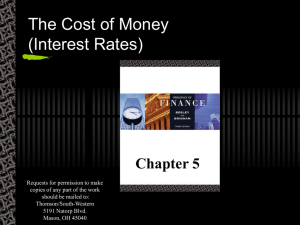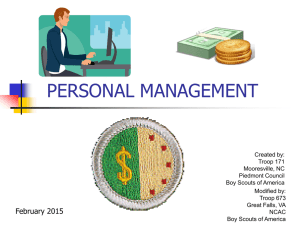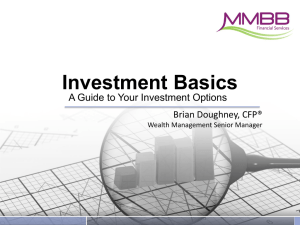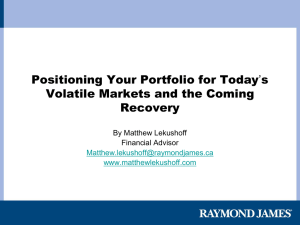Chapter 4 PPP
advertisement
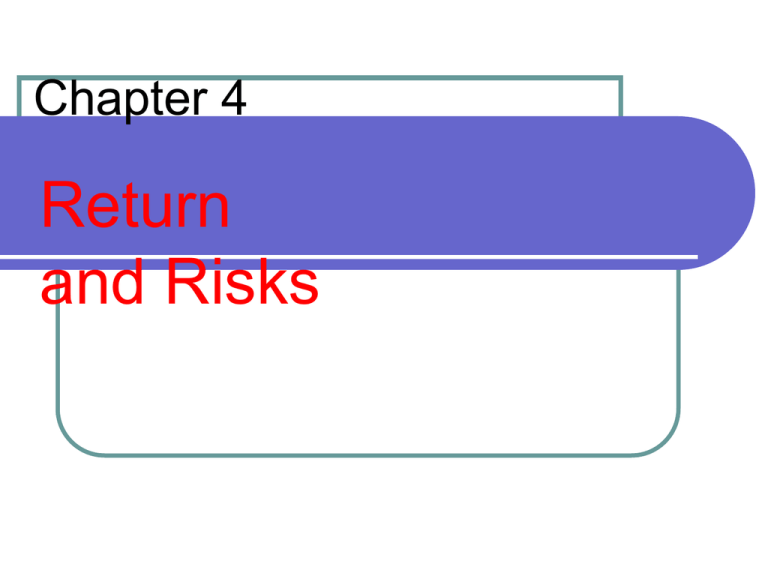
Chapter 4 Return and Risks The Concept of Return Return Components of Return The level of profit from an investment, or The reward for investing Current income: cash or near-cash that is received as a result of owning an investment Capital gains (or losses): the difference between the proceeds from the sale of an investment and its original purchase price Total Return: the sum of the current income and the capital gain (or loss) earned on an investment over a specified period of time 2 Why Return is Important Allows comparison of actual or expected gains with the levels of gain needed Allows us to “keep score” on how our investments are doing compared to our expectations Historical Performance Provides a basis for future expectations Does not guarantee future performance Expected Return Return an investor thinks an investment will earn in the future Determines what an investor is willing to pay for an investment or if they are willing to make an investment 3 Key Factors in Return Internal Forces Type of investment Risks of investment External Forces Political environment Business environment Economic environment Inflation Deflation 4 Historical Returns for Popular Security Investments (1926-2005) 5 The Time Value of Money and Returns The sooner you receive a return on a given investment, the better A dollar received today is worth more than a dollar received in the future The sooner your money can begin earning interest, the faster it will grow 6 Determining a Satisfactory Investment Satisfactory Investment: The one that the present value of benefits equals or exceeds the present value of its costs 7 Measuring Return Required Return The rate of return an investor must earn on an investment to be fully compensated for its risk Required return Risk-free Risk premium on investment j rate for investment j Required return Real rate Expected inflation Risk premium on investment j of return premium for investment j 8 Measuring Return (cont’d) Real Rate of Return The rate of return that could be earned in a perfect world where all outcomes are known and certain— where there was no risk Historically, this amount has remained relatively stable at 0.5% to 2% Expected Inflation Premium The average rate of inflation expected in the future 9 Measuring Return (cont’d) Risk-free Rate The rate of return that can be earned on a risk-free investment The sum of the real rate of return and the expected inflation premium The most common “risk-free” investment is considered to be the 3-month U.S. Treasury Bill Risk-free rate Real rate Expected inflation of return premium RF r * IP 10 Measuring Return (cont’d) Risk Premium Additional return an investor requires on an investment to compensate for higher risks based upon issue and issuer characteristics Issue characteristics are the type, maturity and features Issuer characteristics are industry and company factors 11 Holding Period Return (HPR) Holding Period: the period of time over which an investor wishes to measure the return on an investment vehicle Realized Return: current return actually received by an investor during the given return period Paper Return: return that has been achieved but not yet realized (no sale has taken place) 12 Holding Period Return (HPR) Holding Period Return The total return earned from holding an investment for a specified holding period (usually 1 year or less) Holding period return Current income Capital gain (or loss) during period during period Beginning investment value Capital gain (or loss) Ending Beginning during period investment value investment value 13 Using HPR in Investment Decisions Advantages of Holding Period Return Easy to calculate Easy to understand Considers current income and growth Disadvantages of Holding Period Return Does not consider time value of money Rate may be inaccurate if time period is longer than one year 14 Yield: Internal Rate of Return (IRR) Internal Rate of Return: determines the compound annual rate of return earned on an investment held for longer than one year Yield (IRR) Example: What is the yield (IRR) on an investment costing $1,000 today that you expect will be worth $1,400 at the end of a 5year holding period? 15 Yield Calculation Yield for a Single Cash Flow Cash Flow Future Value $2,950.00 Present Value -$1,500.00 No of Years 5 Yield 14.484% 16 Using IRR in Investment Decisions (cont’d) Advantages of Internal Rate of Return Uses the time value of money Allows investments of different investment periods to be compared with each other If the yield is equal to or greater than the required return, the investment is acceptable Disadvantages of Internal Rate of Return Calculation is complex 17 Yield (IRR) for a Stream of Income Some investments, such as bonds, provide uneven streams of income over the investment period Calculate yield (IRR) by calculating the PV of the different income amounts and adding together Yield Calculation for an $1,1,00 Investment 18 Internal Rate of Return (IRR): Using an Excel Spreadsheet 19 Interest on Interest: The Critical Assumption Using yield (IRR) to measure return assumes that all income earned over the investment horizon is reinvested at the same rate as the original investment. Reinvestment Rate is the rate of return earned on interest or other income received from an investment over its investment horizon. Fully compounded rate of return is the rate of return that includes interest earned on interest. 20 Finding Growth Rates Rate of Growth The compound annual rate of change in the value of a stream of income Used to see how quickly a stream of income, such as dividends, is growing 21 Finding Growth Rates Growth Rate Example: Calculate the rate of growth on the dividend stream Dividends Per Share 22 Finding Growth Rates: Using an Excel Spreadsheet 23 Sources of Risk Risk-Return Tradeoff is the relationship between risk and return, in which investments with more risk should provide higher returns, and vice versa Risk is the chance that the actual return from an investment may differ from what is expected 24 Sources of Risk (cont’d) Currency Exchange Risk is the risk caused by the varying exchange rates between the currencies of two countries. Types of Investments Affected International stocks or ADRs International bonds Examples of Currency Exchange Risk U.S. dollar gets “stronger” against foreign currency, reducing value of foreign investment 25 Sources of Risk (cont’d) Business Risk is the degree of uncertainty associated with an investment’s earnings and the investment’s ability to pay the returns owed to investors. Types of Investments Affected Common stocks Preferred stocks Examples of Business Risk Decline in company profits or market share Bad management decisions 26 Sources of Risk (cont’d) Financial Risk is the degree of uncertainty of payment resulting from a firm’s mix of debt and equity; the larger the proportion of debt financing, the greater this risk. Types of Investments Affected Common stocks Corporate bonds Examples of Financial Risk Company can’t get additional loans for growth or to fund operations Company defaults on bonds 27 Sources of Risk (cont’d) Purchasing Power Risk is the chance that changing price levels (inflation or deflation) will adversely affect investment returns. Types of Investments Affected Bonds (fixed income) Certificates of deposit Examples of Purchasing Power Risk Movie that was $9.00 last year is $10.50 this year 28 Sources of Risk (cont’d) Interest Rate Risk is the chance that changes in interest rates will adversely affect a security’s value. Types of Investments Affected Bonds (fixed income) Preferred stocks Examples of Interest Rate Risk Market values of existing bonds decrease as market interest rates increase Income from an investment is reinvested at a lower interest rate than the original rate 29 Sources of Risk (cont’d) Liquidity Risk is the risk of NOT being able to liquidate an investment conveniently and at a reasonable price. Types of Investments Affected Some small company stocks Real estate Examples of Liquidity Risk The price of a house has to be lowered for a quick sale 30 Sources of Risk (cont’d) Tax Risk is the chance that Congress will make unfavorable changes in tax laws, driving down the after-tax returns and market values of certain investments. Types of Investments Affected Municipal bonds Real estate Examples of Tax Risk Lower tax rates reduce the tax benefit of municipal bond interest Limits on deductions from real estate losses 31 Sources of Risk (cont’d) Market Risk is the risk of decline in investment returns because of market factors independent of the given investment. Types of Investments Affected All types of investments Examples of Market Risk Stock market decline on bad news Political upheaval Changes in economic conditions 32 Sources of Risk (cont’d) Event Risk comes from an unexpected event that has a significant and unusually immediate effect on the underlying value of an investment. Types of Investments Affected All types of investments Examples of Event Risk Decrease in value of insurance company stock after a major hurricane Decrease in value of real estate after a major earthquake 33 Measures of Risk: Single Asset Standard deviation is a statistic used to measure the dispersion (variation) of returns around an asset’s average or expected return Coefficient of variation is a statistic used to measure the relative dispersion of an asset’s returns; it is useful in comparing the risk of assets with differing average or expected returns Higher values for both indicate higher risk 34 Risk-Return Tradeoffs for Various Investment Vehicles 35 Acceptable Levels of Risk Depend Upon the Individual Investor Risk-indifferent describes an investor who does not require a change in return as compensation for greater risk Risk-averse describes an investor who requires greater return in exchange for greater risk Risk-seeking describes an investor who will accept a lower return in exchange for greater risk 36 Steps in the Decision Process: Combining Return and Risk Estimate the expected return using present value methods and historical/projected return rates Assess the risk of the investment by looking at historical/projected returns using standard deviation or coefficient of variation of returns Evaluate the risk-return of each investment alternative to make sure the return is reasonable given the level of risk Select the investment vehicles that offer the highest expected returns associated with the level of risk you are willing to accept 37
